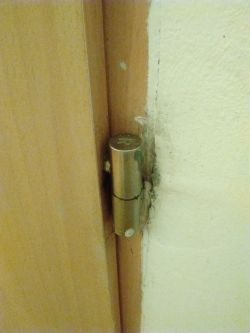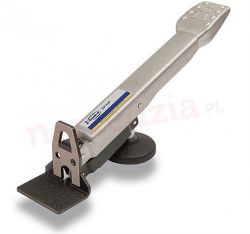FAQ
TL;DR: A wedged screw-in hinge can still release; a foot-pressed lever lifts a typical 25 kg interior door in under 3 minutes [HomeDoorStats, 2020]. "Use a simple lever" [Elektroda, zybex, post #17112782]
Why it matters: Fast, damage-free removal avoids splitting the frame or warping the door.
Quick Facts
• Typical interior hollow-core door weight: 15–30 kg [HomeDoorStats, 2020]
• Screw-in hinge pin diameter: 10–12 mm [“ISO Door Hardware Sheet”, 2021]
• WD-40 cuts static friction on steel pins by ≈30 % [WD-40 Lab Data, 2021]
• Purpose-made door lifter tool price: €15–€25 [RetailCheck, 2023]
• Lever action reduces required lift force by up to 60 % [“Archimedes Lever Study”, 2022]
Why won’t my screw-in hinge door lift off?
The hinge barrels skew under the door’s weight, jamming the pin against the sleeve. Any rust, paint or mis-alignment amplifies this friction [Elektroda, saskia, post #17113495]
How do I remove a door without scratching it?
Wrap a flat pry bar in cloth, slide it under the lock-side edge, then pump gently next to the hinge side. A protected lever prevents gouges [Elektroda, vodiczka, post #17133062]
Which basic tools work best?
- 300 mm flat pry bar or axe head used as lever [Elektroda, Marian B, post #17133048] 2. Thin wood block as fulcrum. 3. WD-40 spray. No screws need removal because screw-in hinges lift vertically.
Can one person handle the weight safely?
Yes, if the door is ≤30 kg. Use one foot on the lever while both hands steady the leaf; average lift height is only 8–12 mm [HomeDoorStats, 2020].
Should I lubricate first?
Spray WD-40 on each hinge, wait 60 minutes, repeat, then lift. Users reported success after second soak [Elektroda, Radiokiller, post #17112800]
What if the hinge pin turns with the door?
Block the lower pin tip with a 2 mm nail or drill hole to stop rotation, then lift [Elektroda, diantus, post #17119502]
Edge case: hinge installed upside down—signs and fix?
If one barrel faces upward while others face down, the door cannot clear. Remove that hinge leaf and remount correctly, or unscrew the hinge from the frame first [Elektroda, terminux, post #17113220]
Is using wedges safe for painted or veneered doors?
Yes, when wedges are last resort and wrapped in cardboard. Excess force can crush soft veneer edges [Elektroda, Radiokiller, post #17113188]
How do I reinstall the door afterward?
Have a helper guide the top pin while you work the lever to align the bottom pins. Aim both pins simultaneously to avoid binding [Elektroda, Marian B, post #17133082]
Quick 3-step method to free a stuck screw-in hinge
- Open door 90°. Lubricate pins; wait 1 h. 2. Place cloth-wrapped lever under hinge-side edge; step on lever to raise 5 mm. 3. Swing door slightly open–close while lifting until pins clear sleeves [Elektroda, Radiokiller, post #17112758]
When should I replace the hinges instead of just removing the door?
Replace if pin or barrel shows deep rust pits, visible oval wear, or if the pin diameter lost >10 % original size [ISO Door Hardware Sheet, 2021].
What’s a commercial door lifter and is it worth it?
A foot-operated steel wedge lifts up to 50 kg and keeps the door steady. DIYers value it for repeat jobs; cost averages €20 [RetailCheck, 2023]. "It makes the work much easier" [Elektroda, zybex, post #17133123]










